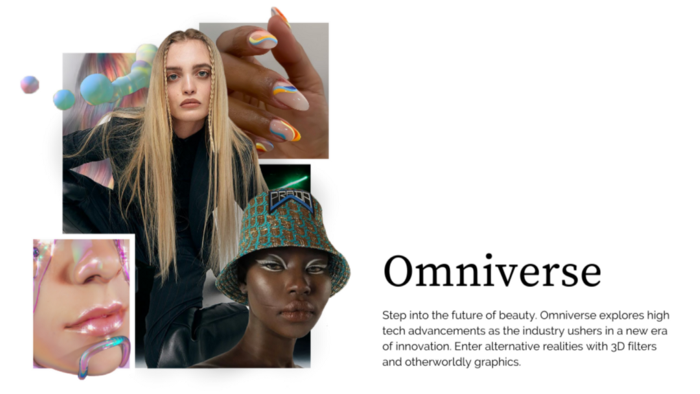2021 Macro Trend: Altered State
We’re entering the next evolution of social connection. As technology continues to permeate every aspect of our lives–more than three-quarters (76%) of global consumers say their everyday lives and activities depend on technology, rising to 79% of gen Z and 80% of millennials–we wonder what comes next. In the company’s most recent keynote, Mark Zuckerberg announced that Facebook is changing its corporate name to Meta as it shifts its focus to the “metaverse,” a shared virtual environment that converges multiple realities for a place to work, play, and socialize. Framed as the future of social media, the metaverse offers a new set of challenges and opportunities to brands and users alike.
As consumers begin replicating their daily habits in the virtual realm, a new market for digital assets emerges. From virtual events to digital fashion, the possibilities within the metaverse are seemingly endless. This year, South by SouthWest (SXSW) created a virtual rendering of downtown Austin that conference goers could explore as an avatar via a computer screen or VR headset. The Fabricant, a virtual fashion house focused on “showing the world that clothing does not need to be physical to exist,” uses 3D modeling software to create outfits for customers’ avatars to wear in digital environments.
Non-fungible tokens (NFTs) have redefined digital ownership. In August 2021, Alibaba launched an NFT auction site for artists, musicians, writers, and game developers to sell NFTs of their work. D&G’s Genesis Collection, the brand’s first collection that included NFTs, fetched approximately $5.65 million in auction. Made in collaboration with UNXD, it broke luxury fashion NFT records. “Fashion has always been an industry at the forefront of conversations on innovation, which have allowed for new ways of thinking about consumption,” says Jawara Alleyne, an emerging designer that recently entered the NFT space.
Our dependence upon technology affects every aspect of our lives, from connection to commerce to creativity. According to Wunderman Thompson, 64% of global consumers say their social life depends on technology, 61% say their livelihood depends on technology, 56% say their creativity depends on technology, 52% say their happiness depends on technology, and 50% say their wellbeing depends on technology. Social platforms are now an integral part of retail and platforms are finding ways to innovate with live shopping and augmented reality. Wunderman Thompson estimates live-streaming sales to be $500 billion by 2023. Searches for “livestream shopping” are +101% to last year. Pinterest, known for mood boards and visual inspiration, has launched a series of live and shoppable videos with its new platform Pinterest TV. In July 2021, Snap purchased Vertebrae, which helps brands create 3D virtual versions of their products, and in August, TikTok announced that it’s building its own AR development platform called TikTok Effect Studio.
Yet, as companies prioritize commerce, consumers still want connection and creativity. 91% of US consumers believe that technology opens up a whole new world of creation, while 65% believe digital craftsmanship requires the same amount of talent and expertise as physical craftsmanship. IMVU, a 3D avatar-based social network, calls creativity “the new status symbol” for the next digital era. When users come onto the platform, “making money is not the most important thing for them. It’s about being recognized for their creations,” Daren Tsui, CEO of the social app explains.
As social media platforms continue to evolve to suit the needs of users, they must also address concerns about data privacy and wellbeing. Pew Research Center findings indicate that Americans feel concerned, confused, and vulnerable about data privacy, and research from Wunderman Thompson reveals that, after being notified of security issues with their personal information or data, 55% of Americans report feeling disoriented, 48% violated, and 37% frightened. In response to these concerns, companies are designing platforms to facilitate digital self-care and pave a healthier path through the data-driven landscape. Last summer, Facebook partnered with The Secondary Education Board in India to create an educational platform on online wellbeing and safety. Earlier in 2020, Mozilla launched the Data Detox Kit, which offers techniques to enhance digital wellbeing such as app cleanses, “locking your digital door,” and protecting virtual valuables. The Kit positions digital security as a pillar of holistic wellbeing.
In the coming years, our dependence upon technology will only increase. While many questions and concerns still remain, it is exciting to consider the endless possibilities at our fingertips. Lindsay Anne Aamodt, senior director of marketing at IMVU, describes the metaverse as “a place of mass audiences, where there’s a true opportunity for brand integration, for brand expansion, and for brand expression.”
Micro Trends
1. Into the Metaverse
“Connection is evolving and so are we.” In the company’s most recent keynote, Mark Zuckerberg announced that Facebook is changing its corporate name to Meta as it shifts its focus to the “metaverse,” a shared virtual environment that converges multiple realities for a place to work, play, and socialize. Meta’s website describes the metaverse as the next evolution of social connection and explores new technologies that will help make this vision come to life. From virtual events to digital fashion, the possibilities within the metaverse are seemingly endless—and already being explored.
2. Social Future
Social platforms are now integral to the retail industry as individuals and brands sell products directly to consumers through Instagram Shop, Facebook Live Shopping, and more. Pinterest, known for mood boards and visual inspiration, will launch a series of live and shoppable videos with its new platform Pinterest TV this November. This shift is supported by data. In 2021, US social commerce sales are expected to rise by 35.8% to $36.62 billion, highlighting the importance of convenience to consumers. Furthermore, 35.9% of US internet users will make at least one social commerce purchase this year. Wunderman Thompson estimates live-streaming sales to be $500 billion by 2023. Searches for “livestream shopping” are +101% to last year. Yet, as companies prioritize commerce, consumers still want creativity and connection.
3. Data Wellbeing
Our increased reliance on technology and social media cause us to question our digital wellbeing and our overall physical wellbeing. With data recently surpassing oil as the world’s most valuable resource, it’s no wonder that the security of our own data is weighing on our minds. Research from Wunderman Thompson reveals that, after being notified of security issues with their personal information or data, 55% of Americans report feeling disoriented, 48% violated, and 37% frightened. In response to consumer concerns, companies are designing platforms to facilitate digital self-care and pave a healthier path through the data-driven landscape.
If you’re interested in the full Altered State report or want to learn more about trends that are growing — and dying, please contact hello@trendalytics.co


